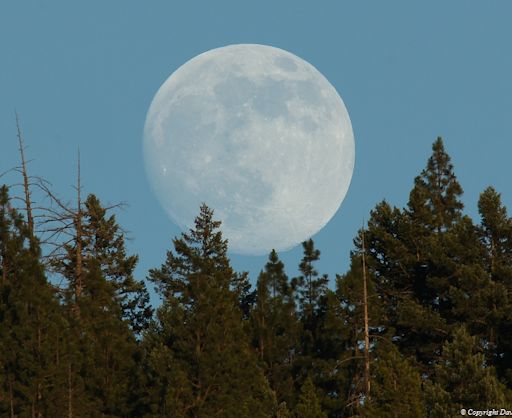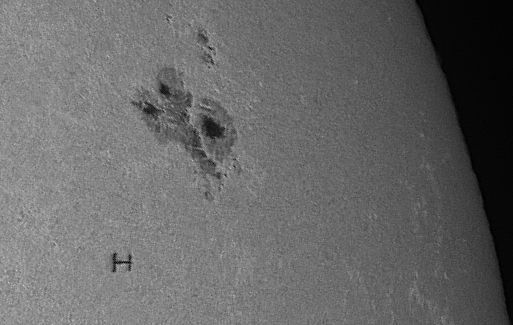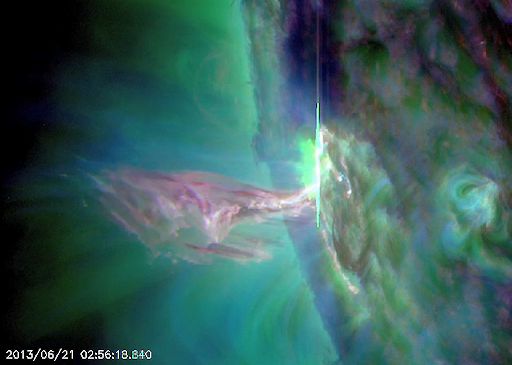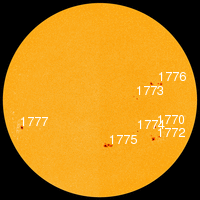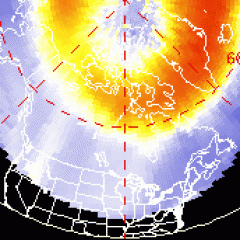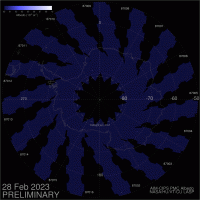SOLAR WIND: A fast-moving (~600 km/s) stream of solar wind is buffeting Earth's magnetic field this weekend. Reports of high-latitude auroras are few, however, because of the nearly full Moon and midnight sun around the Arctic Circle. NOAA forecasters estimate a 40% chance of polar geomagnetic storms on June 22nd. Aurora alerts: text, voice.
SOLSTICE FULL MOON: This weekend's full Moon is a "supermoon," as much as 14% bigger and 30% brighter than other full Moons of 2013. Even on Friday night, 36 hours before maximum illumination, the Moon already looked super:
David Hoffmann took the picture on June 21st from Ashland, Oregon. "The Moon will not be as close to Earth again until August 2014," he says.
The scientific term for the phenomenon is "perigee moon." Full Moons vary in size because of the oval shape of the Moon's orbit. The Moon follows an elliptical path around Earth with one side ("perigee") about 50,000 km closer than the other ("apogee"). Full Moons that occur on the perigee side of the Moon's orbit seem extra big and bright.
On June 23rd, the Moon becomes full at 11:34 UT, only 23 minutes after it reaches perigee. This near-perfect coincidence makes the Moon "super."
It's true that a perigee full Moon brings with it extra-high "perigean tides," but according to the National Oceanic and Atmospheric Administration this is nothing to worry about. In most places, lunar gravity at perigee pulls tide waters only a few centimeters (an inch or so) higher than usual. Local geography can amplify the effect to about 15 centimeters (six inches)--not exactly a great flood.
In other words, don't worry. Just enjoy the super moonlight.
CHINESE SPACE STATION CROSSES THE SUN: Earlier this week in the sunny skies above the south of France, China's experimental Tiangong-1 space station flew directly in front of the sun. Using a filtered 6-inch telescope, astrophotographer Thierry Legault recorded the station's silhouette alongside big sunspot AR1775:
"I recorded two transits--one on June 16 and another on June 17th," says Legault. "They show the Tiangong-1 with 3 taikonauts inside."
Most readers are familiar with the 450-ton International Space Station. Fewer, perhaps, know about China's 8.5-ton Tiangong-1 (Heavenly Palace-1). It was launched in Sept. 2011 to establish a foothold in Earth orbit for China's fledgling space program. Tiangong-1 was briefly boarded by taikonauts (Chinese astronauts) in June 2012, and a second group is onboard now. Three Taikonauts arrived on June 13, 2013, on a 15-day mission to practice rendevous and docking maneuvers and to gain experience living in space. Their expedition is attracting little attention in Western press, but it is being widely followed in China. Earlier this week, more than 60 million students and teachers at 80,000 Chinese schools watched a live lecture by the crew of the Tiangong-1.
According to some reports, the Tiangong-1 will be de-orbited in late 2013 to make way for more advanced experimental stations, Tiangong-2 and Tiangong-3 in the years ahead. Ultimately, China hopes to place an Mir-class station in orbit by 2020.
See the Tiangong-1 before it goes! Spaceweather's Simple Flybys app turns your smartphone into a field-tested space station tracker. It works for both the ISS and the Tiangong-1.
Realtime Space Weather Photo Gallery
SOLSTICE SOLAR FLARE: The northern summer solstice began with a bang. On June 21st at 03:16 UT, sunspot AR1777 produced a long-duration M2-class solar flare. NASA's Solar Dynamics Observatory photographed the flare's extreme ultraviolet flash and a plume of material flying out of the blast site:
As sunspots go, AR1777 is neither large nor apparently menacing, yet it has been crackling with flares for days. Before it rotated over the sun's eastern limb on June 20th, it unleashed a series of farside flares and CMEs. The solstice explosion was not Earth directed, but future explosions could be as the sun's rotation continues to turn AR1777 toward our planet. NOAA forecasters estimate a 30% chance of M-flares and a 5% chance of X-flares during the next 24 hours. Solar flare alerts: text, voice.

Solar wind
speed: 574.5 km/sec
density: 1.2 protons/cm3
explanation | more data
Updated: Today at 1623 UT
X-ray Solar Flares
6-hr max: C1 1418 UT Jun22
24-hr: C1 0506 UT Jun22
explanation | more data
Updated: Today at: 1600 UT
![]()
Daily Sun: 22 Jun 13
Sunspots AR1772, AR1775 and AR1777 pose a threat for M-class solar flares. Credit: SDO/HMI
![]()
Sunspot number: 135
What is the sunspot number?
Updated 22 Jun 2013
Spotless Days
Current Stretch: 0 days
2013 total: 0 days (0%)
2012 total: 0 days (0%)
2011 total: 2 days (<1%)
2010 total: 51 days (14%)
2009 total: 260 days (71%)
Since 2004: 821 days
Typical Solar Min: 486 days
Update 22 Jun 2013
The Radio Sun
10.7 cm flux: 133sfu
explanation | more data
Updated 22 Jun 2013
![]()
Current Auroral Oval:
Switch to: Europe, USA, New Zealand, Antarctica
Credit: NOAA/POES
![]()
Planetary K-index
Now: Kp= 2 quiet
24-hr max: Kp= 4 unsettled
explanation | more data
Interplanetary Mag. Field
Btotal: 5.2 nT
Bz: 1.9 nT south
explanation | more data
Updated: Today at 1627 UT
![]()
Coronal Holes: 21 Jun 13
Earth is inside a stream of solar wind flowing from the indicated coronal hole. Credit: SDO/AIA.
![]()
NEW: Spaceweather.com is now posting daily satellite images of noctilucent clouds (NLCs), which hover over Earth's poles at the edge of space. The data come from NASA's AIM spacecraft. The north polar "daisy" pictured below is a composite of near-realtime images from AIM assembled by researchers at the University of Colorado's Laboratory for Atmospheric and Space Physics (LASP). |
![]() Noctilucent Clouds
Noctilucent Clouds
Switch view: Europe, USA, Asia, Polar
Updated at: 06-21-2013 15:45:01

